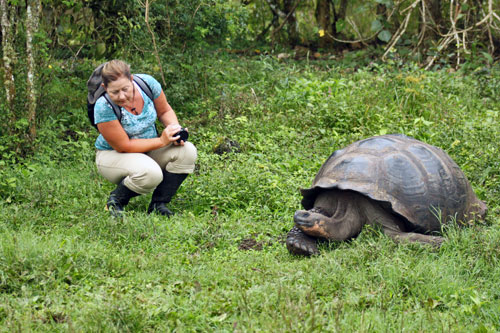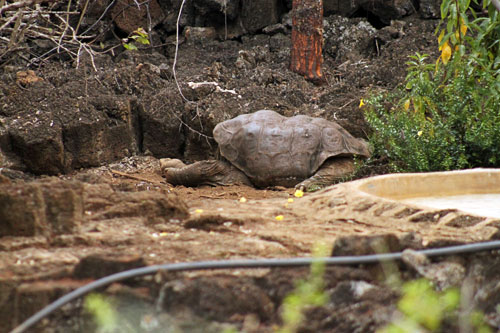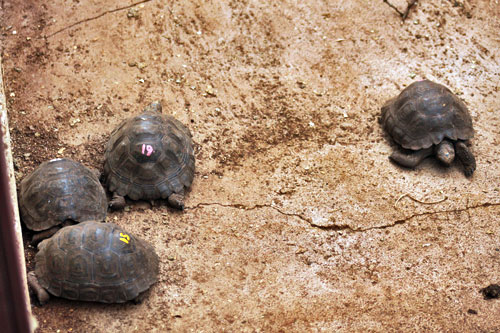After day five of my Galapagos cruise and visits to eight different islands, our naturalists suddenly announced that we hadn’t yet “seen” the Galapagos. Though the islands are famous for uber-friendly sea lions and Blue-Footed Boobies that perform a unique dance as part of their mating ritual, they are best known for their giant land tortoises. Even the name of the archipelago derives from these behemoths. The first humans to visit, 16th century Spanish sailors, dubbed the islands Galapagos, a reference to a type of saddle that resembled the shells of the tortoises. The name stuck and so did the fascination. No visit to these remote volcanic islands is complete without seeing these giant lumbering creatures.

The following day our yacht anchored off Puerto Ayora on the island of Santa Cruz and we boarded a bus for the lush highlands where the giant land tortoises spend most of their year. Stepping quietly through thick grasses, we approached the slow moving creatures from behind so as not to startle them, since they are one of very few species in the Galapagos that exhibit a fear of humans. Considering that their original numbers, estimated to have been in the 250,000 range, were reduced to a mere 3,000 as a result of uncontrolled hunting, it is amazing that they tolerate our presence at all. Most withdrew into their shells as we drew near but a few continued to munch contentedly on the thick, juicy grass and one even stuck its neck out all the way to check out my sister when she squatted down nearby.

Later that same afternoon, at the Charles Darwin Research Center, we learned about ongoing efforts to save the various species of Galapagos tortoises, two of which are already extinct and an additional two that are still in severe danger of extinction. In 1965, on Santa Cruz Island, the Charles Darwin Research Foundation began a breeding and repatriation program for the giant tortoises of Pinzón Island. Over the ensuing years, efforts were expanded to include threatened populations on other islands, including Española, where the population of 15 tortoises had remained static for a number of years.

When the government decided to eradicate the invasive population of rats on Española they removed the remaining tortoises to the Research Center, hoping a controlled environment would induce them to reproduce. But all efforts failed; for some reason the males refused to mate. They had almost given up hope when the San Diego Zoo called with an unexpected bit of news. Their resident Galapagos tortoise, a male from Española, was fighting with all the other males and they offered to send him back home. The Darwin Center named him Diego in honor of the zoo and set him loose with the other Española tortoises. Diego immediately got to work with the ladies and soon spawned a new generation. Even better, the other males, perhaps sensing what they had been missing, suddenly began to breed with a fury. Since then, more than 1,600 tortoises have been repatriated to Española Island.

However, not all efforts have been as successful. Lonesome George, the last remaining tortoise from Pinta Island, sits in an enclosure with two Española females, which are the closest to his species, genetically speaking. If he mates with them, and then again with two successive generations, the species will be 75% genetically similar to George. Unfortunately, Lonesome George shows no propensity to mate.
To ensure that this never again occurs, the Darwin Center conducts a breeding program for all species of Galapagos tortoises. Eggs are collected and placed in temperature-controlled incubators that determine the sex of the offspring. Higher temperatures produce females, while cooler temperatures produce males – the Galapagos equivalent of hot babes and cool dudes. Colored numbers are painted on the shells of the hatchlings – pink for one island, blue for another, etc. – before they are set loose in pens. When their shell curve reaches 20 centimeters, the young tortoises are tagged for future identification and repatriated to their island of origin.

Conservation efforts in Galapagos history began in 1936 when the Ecuadorian government listed the giant tortoise as a protected species and was enhanced with the creation of Galapagos National Park in 1959. Today Ecuador remains committed to the preservation and conservation of all Galapagos species, but perhaps none more so than tortoises. During the 1998 eruption of the Cerro Azul volcano on the island of Isabela, the government spared no expense to safeguard tortoises who were in the path of the lava flow. The Minister of Defense called Luis Hernandez, then an army colonel in charge of operations, and asked if the tortoises could somehow be relocated. “Of course I told him it could be done,” said Hernandez. “We loaded a Lama helicopter inside a C-130 cargo transport aircraft and flew to the Galapagos. For two days we hunted down the endangered animals, strapped them into nets and airlifted them to a safe area of the island.”
Today, tortoises are making a comeback. From their low of 3,000 in 1974, numbers have rebounded to 20,000. Unless a Pinta Island female is discovered and Lonesome George suddenly becomes amorous, it seems likely that the Pinta species will become extinct, but as for the remaining species the future looks bright.
Ecoventura kindly hosted the author’s visit to the Galapagos in Ecuador. However, the receipt and acceptance of complimentary items/services received will never influence the content, topics, or posts in this blog. I write the truth, the whole truth, and nothing but the truth. In this case, I highly recommend Ecoventura, not only for their excellent facilities and the smaller, intimate size of their yachts, but also for their devotion to conservation.

i really liked your story.
A nice story, Barbara, and well told.
Seriously its a giant tortoise… you can see the relativity in first photograph…
It is possible to volunteer on San Cristobal Island in the Galapagos. More information may be found in http://neweragalapagos.blogspot.com.
Wow. That island has a lot to offer and that giant tortoise is WOW..
That’s an AMAZING story – a little male competition goes a long way!! Hope the genetic diversity is enough to ensure survival! The story reminds me of a similar one on Lord Howe Island off the east coast of Australia, where the LHI woodhen was saved from extinction from a core of only 6 breeding adults – the only ones left in the world. What is it about isolated islands??
Thanx for visiting Jim’s guest ‘Red Alert’ post on my blog!
What camera are you using?
I’m in love with them and I haven’t even encountered them yet!!!
It’s a dream of mine to visit this place I consider holy. Thank you for writing so beautifully about your experiences! It’s so encouraging to know people are dedicated to saving these beautiful creatures!
I would go to the Galapagos just to see the tortoises, they really fascinate me. I have seen them in zoos but to see them in the wild must be an amazing experience. I’m glad that so much is being done to help them.
I have seen the giant tortoises in zoos and they are indeed and awesome sight. Let’s hope that the efforts on Galapagos save most of the species and that the numbers continue to rebuild. Also, I agree with your guide – it is the single animal that I most associate with the Galapagos.